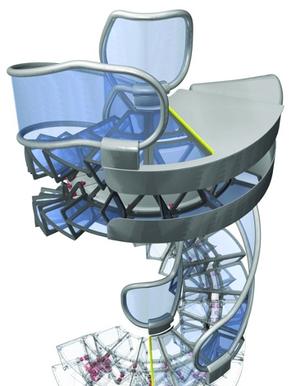Infrastructure Giving crowds a lift with spiral escalator
A monorail-inspired design could help create the world’s first continuous spiral escalator; the spiral escalator could transport larger numbers of people than a lift in a vertical space too narrow for a traditional escalator; this could reduce the floor space needed in buildings for personal transporters and cut the cost of putting escalators into underground railway stations

Cutaway rendering of the spiral escalator // Source: theengineer.co.uk
An Israeli designer has developed a spiral escalator idea as a way of transporting larger numbers of people than a lift in a vertical space too narrow for a traditional escalator. This could reduce the floor space needed in buildings for personal transporters and cut the cost of putting escalators into underground railway stations.
The escalator, which is technically helix shaped rather than spiral, overcomes the problem experienced by conventional machines that are angled so that they travel further horizontally than vertically.
The Engineer reports that curved escalators have existed since the 1980s and are sometimes stacked on top of each other to give the appearance of a helix, but they still rely on the same basic mechanism as straight escalators and are similarly limited in height and length. The “Helixator,” which currently exists as a prototype scale model, has several design innovations that offer the possibility of a continuous helix.
“The big technical breakthrough is the monorail system, which didn’t exist before in the industry,” designer Michel David told the Engineer. “Traditional curved escalator designs comprise multiple rails from both sides of the steps and have to be supported by complex and heavy structures. The monorail solution allows us to concentrate all necessary rails in one central and light structure.”
The Helixator is also driven by a linear motor instead of a chain system where the top link in the chain carries all the weight of the steps.
“This apparatus spreads the force equally along the machine path and does not apply excessive force on any of the chains links,” said David, who is also chief technology officer of the Berlin-based Helixator company. “It allows us to build a particularly flexible system and presents no mechanical limits for geometry, length or height.”
David has produced numerous designs for different sized and shaped Helixators, as well as several 3D-printed scale models. One example is a 100m-high model with accelerating walkways to transport around 20,000 people per hour in both directions, saving floor space equivalent to 15 elevators.
David is now looking for investment to develop an industry-standard prototype to take to manufacturers.
“A lot of people see the design and are afraid they’re going to get dizzy,” he said. “So this is something I’m now working on — what the speed and radius should be. I’m searching for the limit because I want it to go fast and operate in small shafts.”
He said it was too early to predict how much a manufactured unit would cost but that its cost-effectiveness would lie in the reduced supporting architecture needed to fit an escalator in a vertical shaft rather than spreading it across a building.
“Escalators have been manufactured for the last 100 years and today you can buy a unit for €12,000 and that’s really difficult to compete with from an economical point of view. ‘But modern architecture is constantly searching for new things. In some Asian buildings there are already escalators going to the 10th or 15th floors.”
When building the Helixator, David took inspiration from monorails and roller coasters, as well as designs for spiral escalators by Gilbert Luna in the 1970s. He also examined a helical moving walkway “elevator” that was briefly installed in Holloway Road tube station in London in 1906.
The Engineer reported on the technology behind this machine in 1900 when it was first used in the United Kingdom for a straight elevator system at the Crystal Palace.
“The idea of a helical escalator is not new at all — it is 100 years old,” said David. “Studying these attempts is very important to understand why they didn’t work.”
